Microwire-Based Sensor Array for Measuring Wheel Loads of Vehicles
Abstract
1. Introduction
2. Experimental Section
2.1. Microwires
2.2. MMCC Sensors
2.3. Concrete with MMCC Sensors and Strain Gauge
2.4. Test Procedures
2.4.1. Instrumentation
2.4.2. Stress Cycles
2.4.3. Monitoring during the Stress Cycles
2.4.4. Ultrasonic Inspection
3. Results and Discussion
3.1. Ultrasonic Images to Evaluate the Concrete Cube
3.2. Loading and Unloading Test over the Four Sensors
3.3. Results of the Strain Gauge Measurements along Load and Unload Cycles
- (i)
- reduced diameters (with metallic nucleus diameters from about 100 μm down to 0.05 μm);
- (ii)
- existence of insulating glass-coating to suit particular end use requirements.
4. Conclusions
Author Contributions
Funding
Acknowledgments
Conflicts of Interest
References
- Haugen, T.; Levy, J.R.; Aarke, E.; Tello, M.E.P. Weigh-in-Motion equipment-experiences and challenges. Transp. Res. Procedia 2016, 14, 1423–1432. [Google Scholar] [CrossRef]
- Jacob, B.; Beaumelle, V.F.L. Improving truck safety: Potential of weigh-in-motion technology. IATSS Res. 2010, 34, 9–15. [Google Scholar] [CrossRef]
- Cheng, L.; Zhang, H.J.; Li, Q. Design of a capacitive flexible weighing sensor for vehicle WIM system. Sensors 2007, 7, 1530–1544. [Google Scholar] [CrossRef]
- Malla, R.; Sen, A.; Garrick, N. A special fiber optic sensor for measuring wheel loads of vehicles on highways. Sensors 2008, 8, 2551–2568. [Google Scholar] [CrossRef]
- Jacob, B.; Cottineau, L.-M. Weigh-in-motion for direct enforcement of overloaded commercial vehicles. Transp. Res. Procedia 2016, 14, 1413–1422. [Google Scholar] [CrossRef]
- McCall, B.; Vodrazka, W. States Successful Practices Weigh-In-Motion Handbook; U.S Department Transportation, Federal Highway Administration: Washington, DC, USA, 1997. [Google Scholar]
- Zou, X.; Chao, A.; Wu, N.; Tian, Y.; Yu, T.-Y.; Wang, X. Miniature fiber optic temperature sensor for concrete structural health monitoring. In Proceedings of SPIE, Sensors and Smart Structures Technologies for Civil, Mechanical, and Aerospace Systems 2012; SPIE: San Diego, CA, USA, 2012; Volume 8345. [Google Scholar]
- Zhou, S.; Deng, F.; Yu, L.; Li, B.; Wu, X.; Yin, B. A Novel Passive Wireless Sensor for Concrete Humidity Monitoring. Sensors 2016, 16, 1535. [Google Scholar] [CrossRef]
- Duffó, G.S.; Farina, S.B. Development of an embeddable sensor to monitor the corrosion process of new and existing reinforced concrete structures. Constr. Build. Mater. 2009, 23, 2746–2751. [Google Scholar] [CrossRef]
- Zhukov, A. Novel Functional Magnetic Materials: Fundamentals and Applications; Springer: Berlin, Germany, 2016. [Google Scholar]
- Vazquez, M. Magnetic Nano—and Microwires. Design, Synthesis, Properties and Applications; Woodhead Publishing Series in Electronic and Optical Materials; Elsevier: Cambridge, UK, 2016. [Google Scholar]
- Zhukov, A.; Ipatov, M.; Churyukanova, M.; Talaat, A.; Blanco, J.M.; Zhukova, V. Trends in optimization of giant magnetoimpedance effect in amorphous and nanocrystalline materials. J. Alloys Compd. 2017, 727, 887–901. [Google Scholar] [CrossRef]
- Zhukov, A.; González, J.; Blanco, J.M.; Vazquez, M.; Larin, V.; Torcunov, A. Nanocrystalline and Amorphous Magnetic Microwires. In Encyclopedia of Nanoscience and Nanotechnology; Nalwa, H.S., Ed.; American Scientific Publishers: Valencia, CA, USA, 2004; Chapter 62; pp. 365–387. [Google Scholar]
- Praslička, D.; Blažek, J.; Šmelko, M.; Hudák, J.; Čverha, A.; Mikita, I.; Varga, R.; Zhukov, A. Possibilities of Measuring Stress and Health Monitoring in Materials Using Contact-Less Sensor Based on Magnetic Microwires. IEEE Trans. Magn. 2013, 49, 128–131. [Google Scholar] [CrossRef]
- Taylor, G.F. A method of drawing metallic filaments and a discussion of their properties and uses. Phys. Rev. 1923, 23, 655–660. [Google Scholar] [CrossRef]
- Larin, V.S.; Torcunov, A.V.; Zhukov, A.; González, J.; Vazquez, M.; Panina, L. Preparation and properties of glass-coated microwires. J. Magn. Magn. Mater. 2002, 249, 39–45. [Google Scholar] [CrossRef]
- Baranov, S.A.; Larin, V.S.; Torcunov, A.V. Technology, preparation and properties of the cast glass-coated magnetic microwires. Crystals 2017, 7, 136. [Google Scholar] [CrossRef]
- Chiriac, H.; Óvári, T.A. Amorphous glass-covered magnetic wires: Preparation, properties, applications. Prog. Mater. Sci. 1996, 40, 333–407. [Google Scholar] [CrossRef]
- Olivera, J.; Varga, R.; Prida, V.M.; Sanchez, M.L.; Hernando, B.; Zhukov, A. Domain wall dynamics during the devitrification of Fe73.5Cu1Nb3Si11.5B11 magnetic microwires. Phys. Rev. B 2010, 82, 094414. [Google Scholar] [CrossRef]
- Makhnovskiy, D.; Zhukov, A.; Zhukova, V.; Gonzalez, J. Tunable and self-sensing microwave composite materials incorporating ferromagnetic microwires. Adv. Sci. Technol. 2008, 54, 201–210. [Google Scholar] [CrossRef]
- Ipatov, M.; Zhukova, V.; Zhukov, A.; Panina, L.V. Microwave metamaterials containing magnetically soft microwires. Adv. Sci. Technol. 2010, 75, 224–229. [Google Scholar] [CrossRef]
- Panina, L.; Ipatov, M.; Zhukova Gonzalez, J.; Zhukov, A. Tuneable composites containing magnetic microwires. In Metal, Ceramic and Polymeric Composites for Various Uses; Intech-Open Acess Publisher: Rijeka, Croatia, 2011; Chapter 22; pp. 431–460. [Google Scholar]
- Olivera, J.; Gonzalez, M.; Fuente, J.V.; Varga, R.; Zhukov, A.; Anaya, J.J. An embedded stress sensor for concrete SHM based on amorphous ferromagnetic microwires. Sensors 2014, 14, 19963–19978. [Google Scholar] [CrossRef]
- Zhukova, V.; Blanco, J.M.; Rodionova, V.; Ipatov, M.; Zhukov, A. Domain wall propagation in micrometric wires: Limits of single domain wall regime. J. Appl. Phys. 2012, 111, 07E311. [Google Scholar] [CrossRef]
- Varga, R.; García, K.L.; Vázquez, M.; Zhukov, A.; Vojtanik, P. Switching-field distribution in amorphous magnetic bistable microwires. Phys. Rev. B 2004, 70, 024402. [Google Scholar] [CrossRef]
- Sabol, R.; Varga, R.; Hudak, J.; Blazek, J.; Praslicka, D.; Vojtanik, P.; Badini, G.; Vazquez, M. Temperature and frequency dependencies of the switching field in glass-coated FeNbSiB microwires. J. Appl. Phys. 2012, 111, 141–143. [Google Scholar] [CrossRef]
- Churyukanova, M.; Kaloshkin, S.; Shuvaeva, E.; Stepashkin, A.; Zhdanova, M.; Aronin, A.; Aksenov, O.; Arakelov, P.; Zhukov, V.; Zhukov, A. Non-contact method for stress monitoring based on stress dependence of magnetic properties of Fe-based microwires. J. Alloys Compd. 2018, 748, 199–205. [Google Scholar] [CrossRef]
- Allue, A.; Corte-León, P.; Gondra, K.; Zhukova, V.; Ipatov, M.; Blanco, J.M.; Gonzalez, J.; Churyukanova, M.; Taskaev, S.; Zhukov, A. Smart composites with embedded magnetic microwire inclusions allowing non-contact stresses and temperature monitoring. Compos. Part A Appl. Sci. Manuf. 2019, 120, 12–20. [Google Scholar] [CrossRef]
- Hudak, R.; Varga, R.; Hudak, J.; Praslicka, D.; Polacek, I.; El Kammouni, R.; Vazquez, M. Influence of fixation on magnetic properties of glass-coated magnetic microwires for biomedical applications. IEEE Trans. Magn. 2015, 51, 5200104. [Google Scholar] [CrossRef]
- Kroll, K.; Young, M.; Kroll, K. Strain Gauge Strip Sensor for Precision Weigh-InMotion; Intercomp: Medina, MN, USA, 2015. [Google Scholar]
- Aragoneses, P.; Blanco, J.M.; Dominguez, L.; González, J.; Zhukov, A.; Vázquez, M. The Stress dependence of the switching field in glass-coated amorphous microwires. J. Phys. D Appl. Phys. 1998, 31, 3040–3045. [Google Scholar] [CrossRef]
- Corte-Leon, P.; Zhukova, V.; Ipatov, M.; Blanco, J.M.; Gonzalez, J.; Churyukanova, M.; Baraibar, J.M.; Taskaev, S.; Zhukov, A. Stress dependence of the magnetic properties of glass-coated amorphous microwires. J. Alloys Compd. 2019, 789, 201–208. [Google Scholar] [CrossRef]
- Varga, R.; Gamcova, J.; Llein, P.; Kovac, J.; Zhukov, A. Tailoring the switching field dependence on external parameters in magnetic microwires. IEEE Trans. Magn. 2013, 49, 30–33. [Google Scholar] [CrossRef]
- Novak, R.L.; Sinnecker, J.P.; Chiriac, H. Annealing effects on the magnetization reversal and domain wall dynamics in bistable amorphous glass-covered microwires. J. Phys. D Appl. Phys. 2008, 41, 095005. [Google Scholar] [CrossRef]
- Zhukova, V.; Blanco, J.M.; Ipatov, M.; Gonzalez, J.; Churyukanova, M.; Zhukov, A. Engineering of magnetic softness and giant magnetoimpedance effect in Fe-rich microwires by stress-annealing. Scr. Mater. 2018, 142, 10–14. [Google Scholar] [CrossRef]
- Talaat, A.; del Val, J.J.; Zhukova, V.; Ipatov, M.; Klein, P.; Varga, R. Effect of annealing on magnetic properties of nanocrystalline Hitperm-type glass coated microwires. J. Alloy Compd. 2016, 660, 297–303. [Google Scholar] [CrossRef]
- Sixtus, K.J.; Tonks, L. Propagation of Large Barkhausen Discontinuities II. Phys. Rev. Lett. 1932, 42, 419–435. [Google Scholar] [CrossRef]
- Molero, M.; Aparicio, S.; Al-Assadi, G.; Casati, M.J.; Hernández, M.G.; Anaya, J.J. Evaluation of freeze-thaw damage in concrete by ultrasonic imaging. NDT E Int. 2012, 52, 86–94. [Google Scholar] [CrossRef]
- Ranz, J.; Aparicio, S.; Romero, H.; Casati, M.J.; Molero, M.; González, M. Monitoring of freeze-thaw cycles in concrete using embedded sensors and ultrasonic imaging. Sensors 2014, 14, 2280–2304. [Google Scholar] [CrossRef] [PubMed]
- Ju, T.; Achenbach, J.D.; Jacobs, L.J.; Guimaraes, M.; Qu, J. Ultrasonic nondestructive evaluation of alkali–silica reaction damage in concrete prism samples. Mater. Struct. 2017, 50, 60. [Google Scholar] [CrossRef]
- Marcantonio, V.; Monarca, D.; Colantoni, A.; Cecchini, M. Ultrasonic waves for materials evaluation in fatigue, thermal and corrosion damage: A review. Mech. Syst. Signal Process. 2019, 120, 32–42. [Google Scholar] [CrossRef]
- Narita, F.; Fox, M. A Review on Piezoelectric, Magnetostrictive, and Magnetoelectric Materials and Device Technologies for Energy Harvesting Applications. Adv. Eng. Mater. 2018, 20, 1700743. [Google Scholar] [CrossRef]
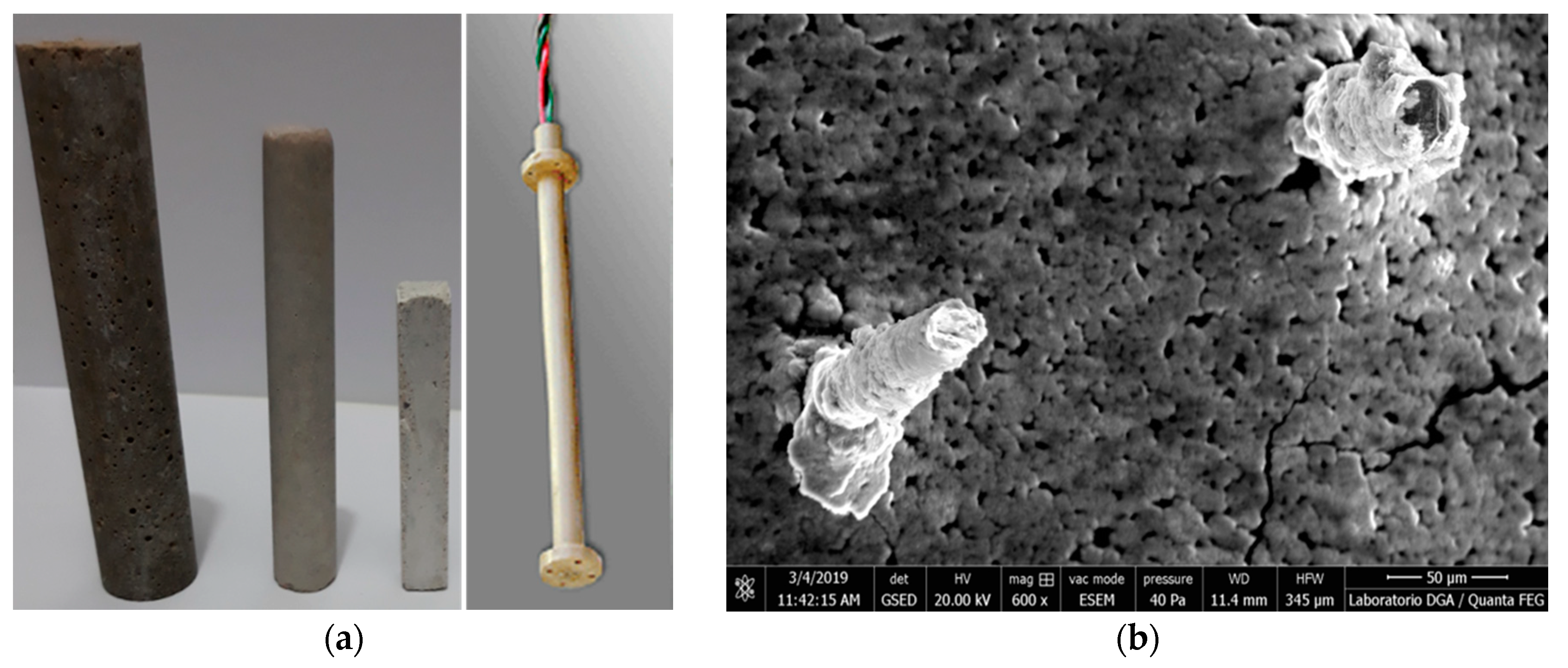
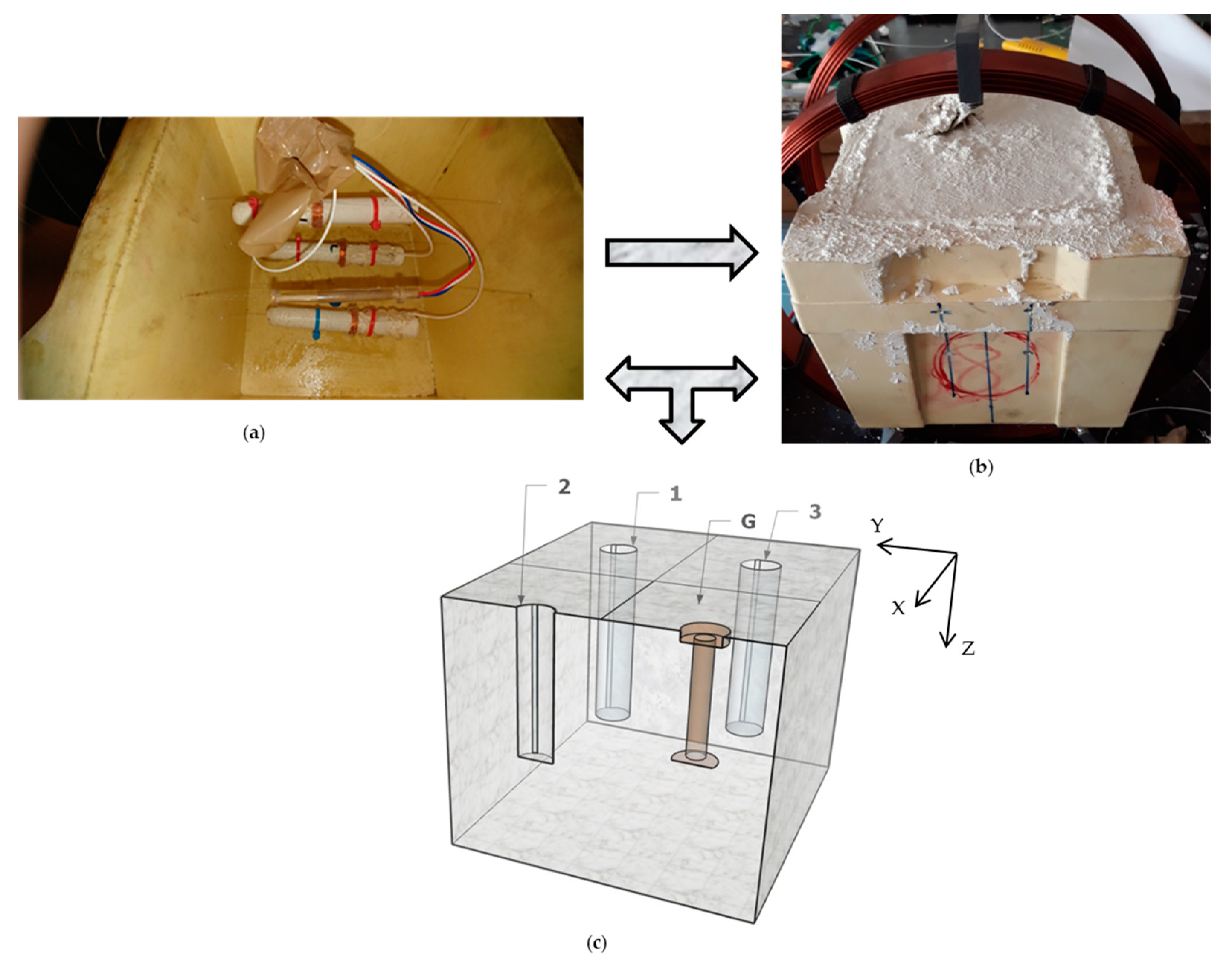
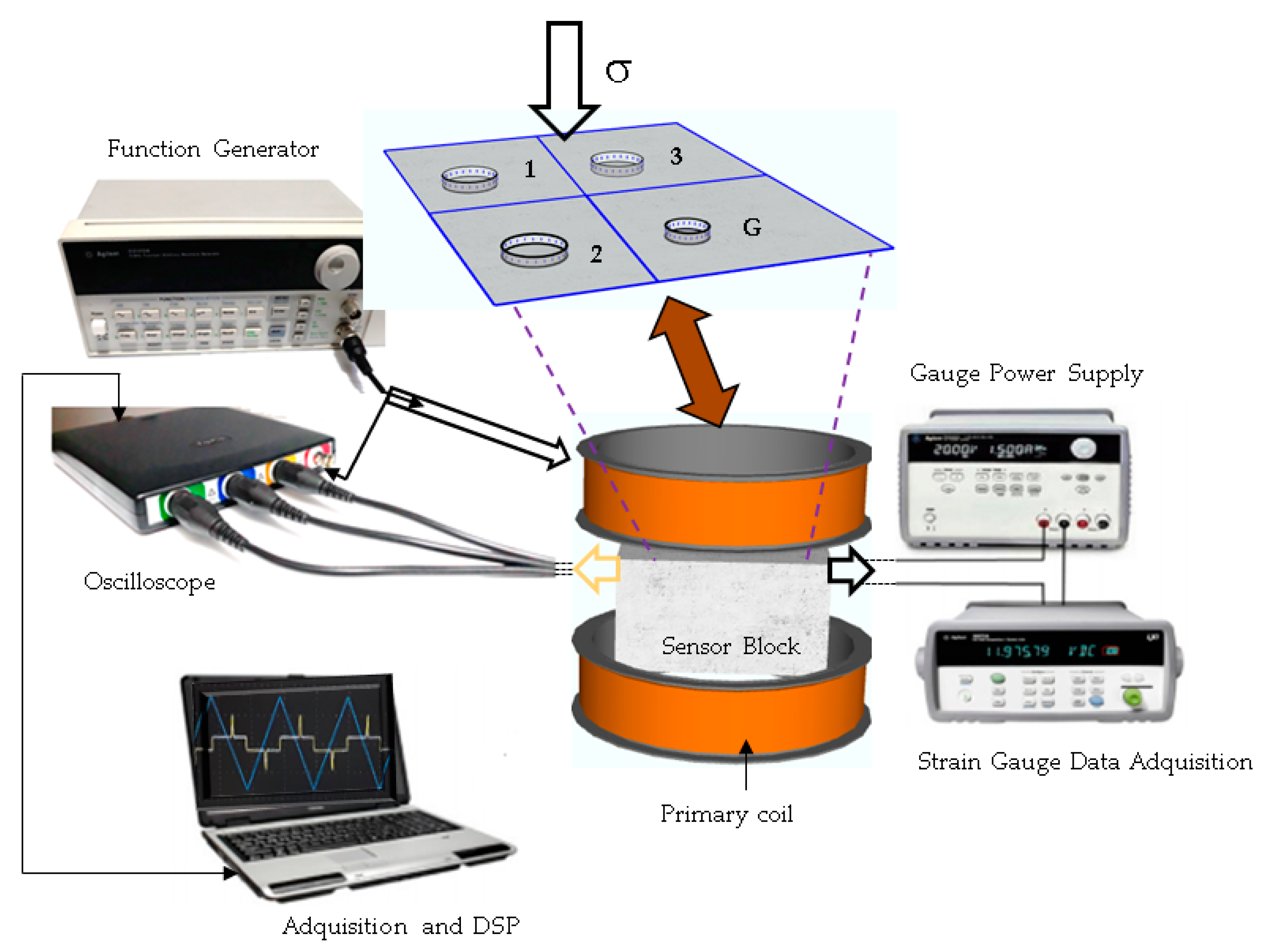
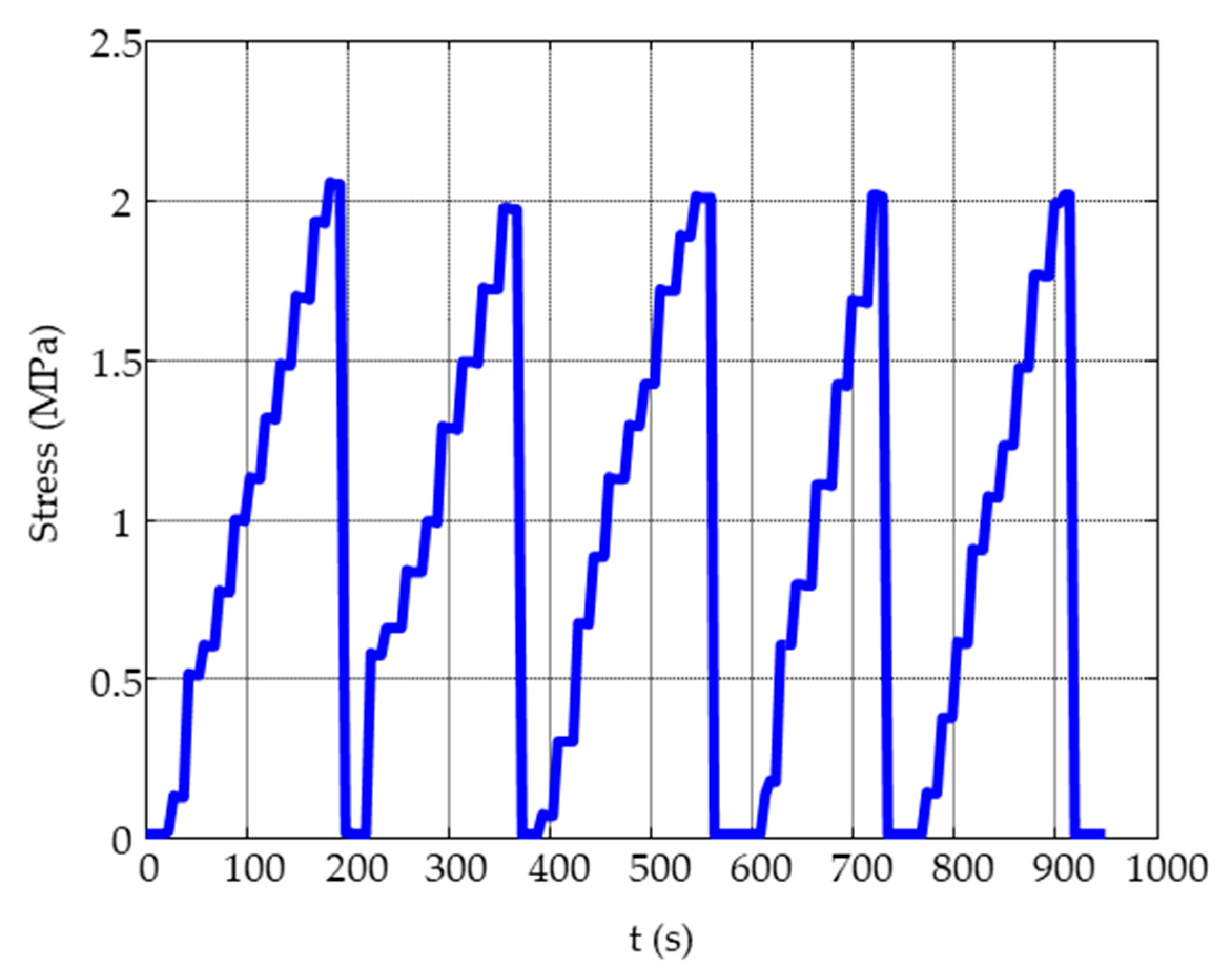
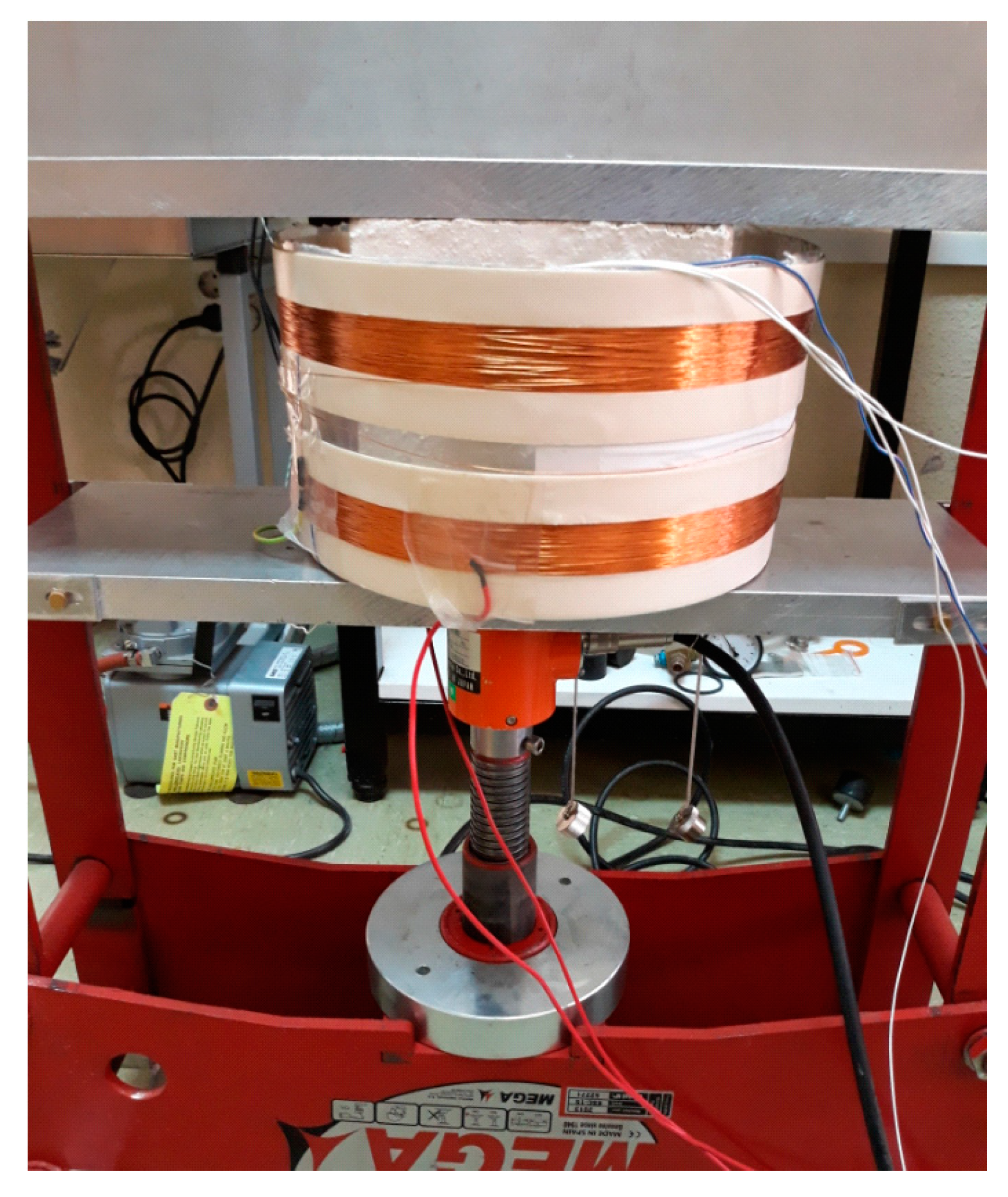

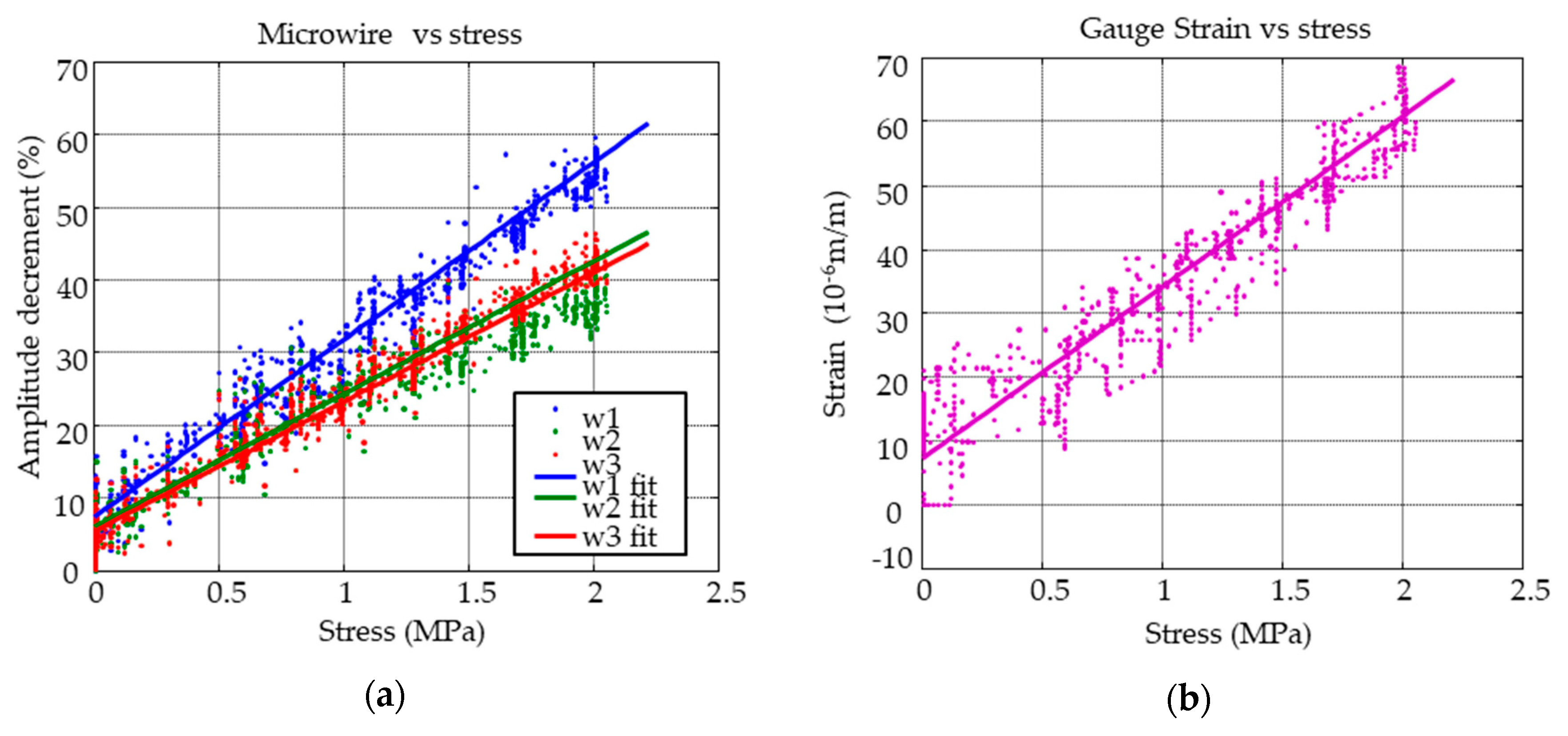
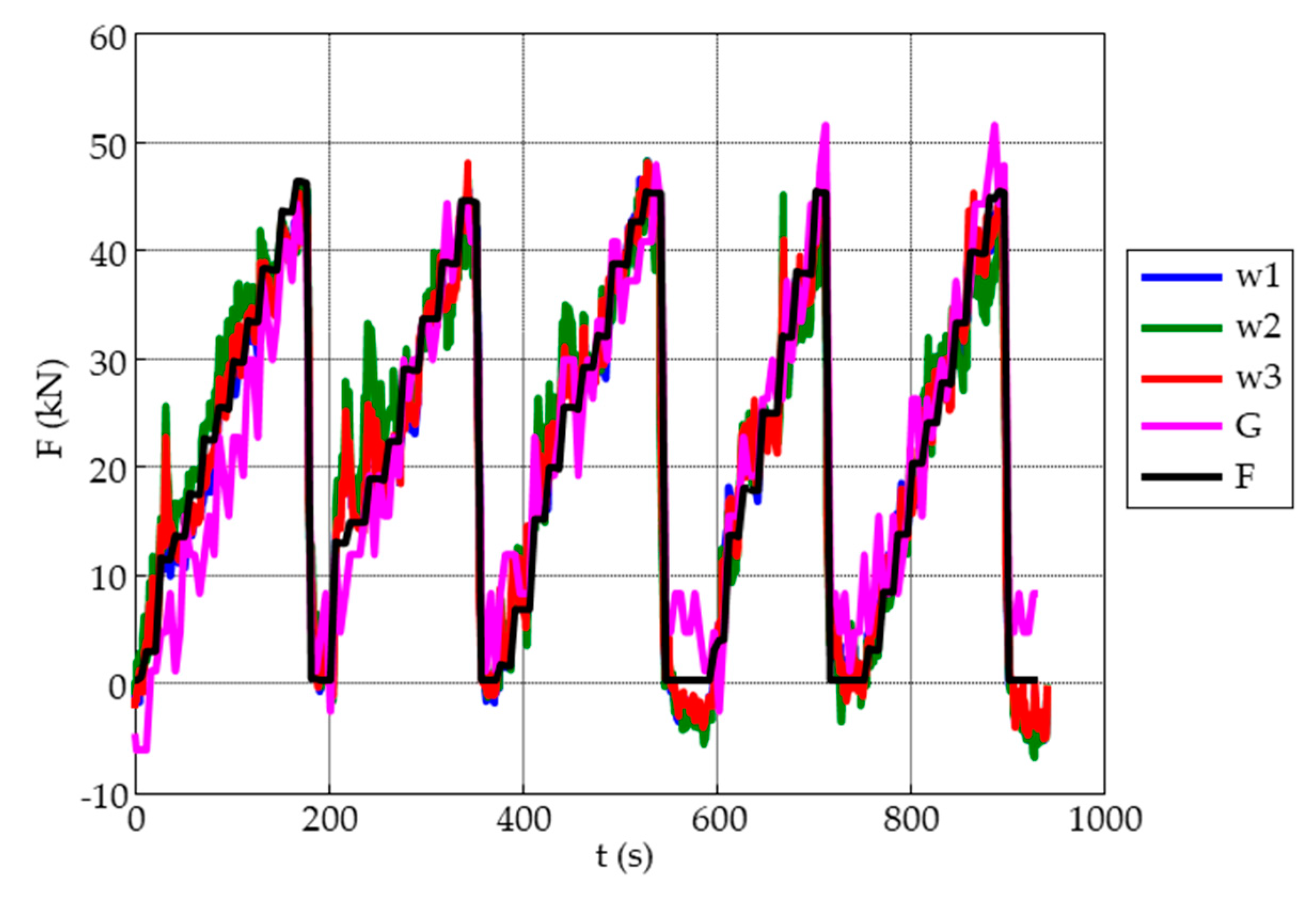

| Materials | Mortar | Concrete |
|---|---|---|
| White cement I 52.5R | 0.225 kg | 218 kg/m3 |
| Siliceous sand | 0.675 kg | 374 kg/m3 |
| Water | 0.101 kg | 82.6 kg/m3 |
| Gravel 0–4 | 255 kg/m3 | |
| Gravel 8–12 | 206 kg/m3 | |
| Sika Viscocrete 5990 | 2.2% of weight of cement | 1% of weight of cement |
© 2019 by the authors. Licensee MDPI, Basel, Switzerland. This article is an open access article distributed under the terms and conditions of the Creative Commons Attribution (CC BY) license (http://creativecommons.org/licenses/by/4.0/).
Share and Cite
Olivera, J.; Aparicio, S.; Hernández, M.G.; Zhukov, A.; Varga, R.; Campusano, M.; Echavarria, E.; Anaya Velayos, J.J. Microwire-Based Sensor Array for Measuring Wheel Loads of Vehicles. Sensors 2019, 19, 4658. https://doi.org/10.3390/s19214658
Olivera J, Aparicio S, Hernández MG, Zhukov A, Varga R, Campusano M, Echavarria E, Anaya Velayos JJ. Microwire-Based Sensor Array for Measuring Wheel Loads of Vehicles. Sensors. 2019; 19(21):4658. https://doi.org/10.3390/s19214658
Chicago/Turabian StyleOlivera, Jesus, Sofia Aparicio, Margarita Gonzalez Hernández, Arcady Zhukov, Rastislav Varga, Maximo Campusano, Enmanuel Echavarria, and Jose Javier Anaya Velayos. 2019. "Microwire-Based Sensor Array for Measuring Wheel Loads of Vehicles" Sensors 19, no. 21: 4658. https://doi.org/10.3390/s19214658
APA StyleOlivera, J., Aparicio, S., Hernández, M. G., Zhukov, A., Varga, R., Campusano, M., Echavarria, E., & Anaya Velayos, J. J. (2019). Microwire-Based Sensor Array for Measuring Wheel Loads of Vehicles. Sensors, 19(21), 4658. https://doi.org/10.3390/s19214658





